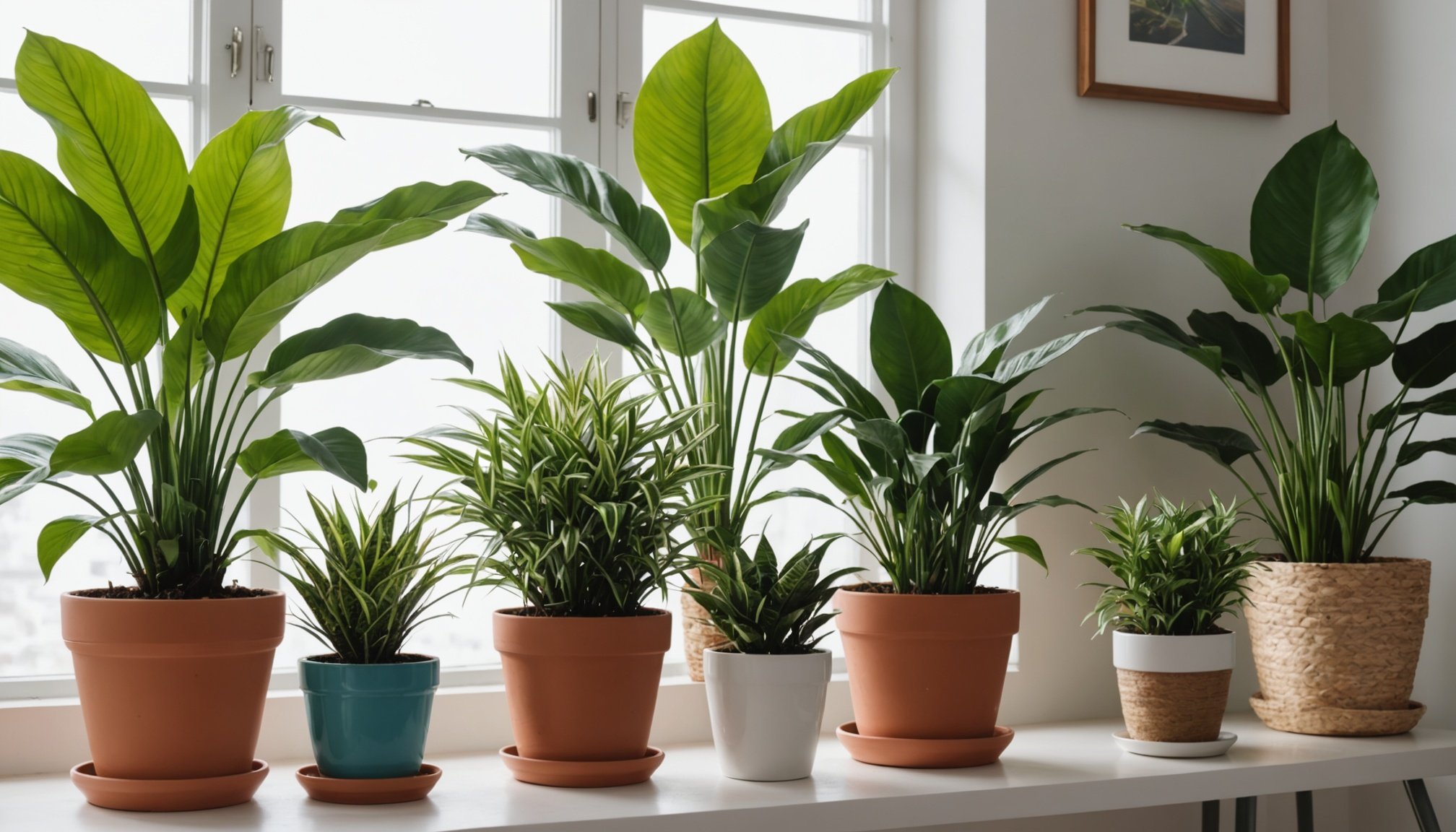Introduction to Allergy-friendly Indoor Plants
Incorporating allergy-friendly indoor plants into your home can significantly enhance indoor air quality, offering a haven for allergy sufferers. These plants not only beautify spaces but also contribute to creating a sanctuary that fosters wellbeing.
For individuals sensitive to allergens, the presence of common air quality issues, such as dust and pollen, can lead to discomfort. Therefore, selecting specific indoor plants can alleviate symptoms and improve living conditions. By reducing allergens, these plants help establish an environment conducive to healthy living, minimizing common irritants.
Have you seen this : Paws and Passages: Crafting Modern Homes with Smooth Indoor-Outdoor Access for Pets
Indoor plants have proven capabilities in purifying the air by absorbing airborne toxins and releasing oxygen. Hence, their role in combating poor air quality should not be underestimated. Popular choices are known for their low allergenic properties, making them excellent candidates for improving air quality. Furthermore, each plant offers unique benefits, such as acting as natural humidifiers or neutralizing odours, thus contributing to an allergen-free living space.
Understanding the specifics of indoor air quality concerns is crucial. Elements like volatile organic compounds (VOCs), mould spores, and pet dander are often found indoors. Plants can address these issues, ensuring a safe and clean sanctuary for all.
Also to see : Crafting your dream succulent sanctuary: essential tips for flourishing in dry climates
Top Allergy-friendly Indoor Plants
When considering the best indoor plants for those with allergies, it’s crucial to focus on low-allergen plants that still offer air-purifying benefits. These allergy-friendly options can transform your living space into a haven without the common concerns of pollen or dust accumulation.
Plants such as the Spider Plant, Snake Plant, and Peace Lily are renowned for their low allergenic properties. Characterized by their ability to thrive in various environments, these plants are not only easy to maintain but also effective in removing toxins and improving indoor air quality. Another standout is the Bamboo Palm, celebrated for its high moisture content which can help reduce airborne allergens.
For allergy sufferers, selecting plants that suit their specific environment is paramount. In well-lit spaces, Aloe Vera and Boston Fern are excellent options due to their resilience and air-purifying capabilities. Meanwhile, in low-light conditions, the Lady Palm and Dracaena Marginata offer similar benefits without requiring extensive sunlight.
Each plant brings its unique characteristics, ensuring there is an ideal choice for various preferences and spaces. By incorporating these plants into different areas of your home, you can effectively create a serene, allergen-free environment tailored to your needs.
Care and Maintenance of Allergy-friendly Plants
Caring for allergy-friendly indoor plants involves a few simple steps to ensure they thrive while maintaining a clean environment. Proper plant care significantly boosts their air-purifying abilities, contributing to overall indoor air quality.
Begin with selecting the right soil. Opt for well-draining, peat-based potting mixes to prevent waterlogging and reduce mould growth. It’s essential to monitor humidity levels, as excess moisture can promote the growth of mould and mildew, potentially increasing allergens.
Maintenance tips include regular dusting of leaves with a damp cloth. This keeps the leaves free of dust, which can harbor allergens, and enhances the plants’ ability to purify air. Also, consistent but moderate watering, resembling each plant’s natural environment, goes a long way in nurturing health without inviting fungal issues.
Address common issues by routinely checking for signs of pests or diseases. Use organic and non-toxic remedies to deal with them effectively, ensuring the plant remains safe for allergy sufferers. Light exposure must be tailored to each plant’s needs; position them in spots that align with their sunlight requirements to boost growth while preventing stress.
Implementing these best practices for plant care cultivates a healthy haven, maximising the potential of air-purifying plants.
Benefits of Choosing Allergy-friendly Indoor Plants
Choosing allergy-friendly indoor plants delivers a multitude of health benefits, predominantly by enhancing indoor air quality. These plants excel in absorbing harmful toxins and releasing oxygen, which purifies the air, thus offering a healthier living environment. With low allergenic properties, they significantly reduce common irritants, making them an ideal choice for allergy sufferers.
Apart from air purification, these plants also contribute to the psychological and emotional wellbeing of individuals. The presence of greenery indoors has been linked to decreased stress levels and improved mood. This harmonious interaction not only boosts mental clarity but also fosters a sense of tranquility, transforming living spaces into genuine sanctuaries.
There is substantial evidence supporting the effectiveness of certain indoor plants in reducing allergens. The Spider Plant, for instance, is celebrated for its ability to combat indoor pollutants and allergens effectively. Having such plants around is not just about aesthetics but enhancing your physical and mental health concurrently.
Ultimately, integrating these plants into your living space can offer a balance of fresh air and improved wellbeing. Selecting the right plants creates a nurturing environment that promotes both comfort and health, underscoring the unique benefits of having allergy-friendly indoor plants at home.
Optimal Placement and Arrangement of Plants
Achieving the ideal setup for your allergy-friendly indoor plants involves strategically positioning them to maximise both air quality and aesthetic appeal. Careful placement and arrangement of plants can transform any room into a serene haven, enhancing the overall atmosphere of your living environment.
Plant placement plays a crucial role in optimising air purification. Position plants in areas where air circulation is poor to boost their efficiency in improving indoor air quality. Bedrooms benefit from plants like the Snake Plant that absorbs carbon dioxide and releases oxygen during nighttime, enhancing sleep quality.
When arranging plants, consider combining height and texture for a dynamic appearance. Use creative ideas such as hanging baskets or placing plants on shelves to make use of vertical spaces without cluttering floors. Grouping plants with similar care needs also simplifies maintenance, contributing to a calming indoor sanctuary.
Incorporate plants into different room types by choosing varieties that match the lighting and space characteristics. For small spaces, opt for compact plants like succulents, while larger areas can accommodate more significant species like the Rubber Plant. Balancing plant placement with decor ensures your environment stays both visually appealing and beneficial for air quality.
Considerations for Indoor Air Quality
Understanding the presence of indoor air pollutants is essential for maintaining a healthy living space, particularly for those sensitive to allergens. Common sources include VOCs from household products, mould spores, and pet dander. These pollutants can exacerbate allergy symptoms and should be addressed.
Plants play a significant role in combating these pollutants. By enhancing air purification, they help reduce the levels of allergens found indoors. Some plants are known to absorb harmful chemicals like formaldehyde and benzene, contributing to better air quality.
However, integrating plants is just part of the solution. Incorporating additional practices can further improve indoor air. Regular cleaning to remove dust and periodic airing out of rooms are practical steps. Utilizing air purifiers can also be beneficial, especially in conjunction with the natural purification process that plants provide.
To maximise the benefits, consider a combination of plant care and environmental practices. Opt for plants known for strong air-purifying properties and position them strategically. Balance this with regular maintenance and cleaning routines, ensuring you’re tackling the full spectrum of indoor air quality challenges to create a healthier home environment.
Practical Steps to Create Your Sanctuary
Transforming your home into a sanctuary requires careful planning and thoughtful design choices. Begin by selecting allergy-friendly indoor plants that enhance indoor air quality. Focus on plants like Spider Plant or Peace Lily, known for purifying the air and reducing allergens. Their effectiveness in creating a more breathable environment makes them ideal for crafting a peaceful space.
Step-by-Step Guide
-
Plant Selection: Choose plants that best suit your space, considering light conditions and maintenance needs. Whether it’s a sun-soaked corner or a darker alcove, there’s a suitable plant for every environment.
-
Creative Integration: Arrange plants to complement your existing décor. Use hanging baskets or corner stands to save space while maintaining visual appeal. Ensure you place plants where they can maximize their air-purifying properties.
-
Routine Maintenance: Incorporate regular plant care into your routine to uphold the tranquility. Simple tasks like removing dust from leaves and monitoring moisture contribute significantly to maintaining an allergen-free environment.
By following these steps, you can customize your indoor environment, fostering both comfort and serenity. A well-maintained sanctuary becomes a personal retreat, promoting relaxation and wellbeing.
Considerations for Indoor Air Quality
Understanding indoor air pollutants is crucial for maintaining a healthy home environment, especially for those sensitive to allergens. Common offenders include volatile organic compounds (VOCs), mould spores, and pet dander, each contributing to poor air quality. These pollutants can aggravate allergy symptoms, necessitating proactive management.
Plants play a pivotal role in addressing these concerns by naturally purifying the air. Some species possess the ability to absorb harmful chemicals like formaldehyde and benzene, thus reducing allergens. This air purification process is a cornerstone of creating a more breathable space.
Beyond plants, enhancing indoor air quality requires incorporating additional practices. Consistent cleaning to eliminate dust and regular ventilation of rooms are effective measures. Moreover, integrating air purifiers can significantly complement the natural benefits that plants provide.
To optimise air quality in your home, consider a holistic approach that combines plant care with environmental practices. Select plants known for their robust air-purifying capabilities and strategically place them throughout your home. By coupling these strategies with regular cleaning, you ensure a thorough approach to tackling indoor air challenges, crafting a healthier living space for all.

